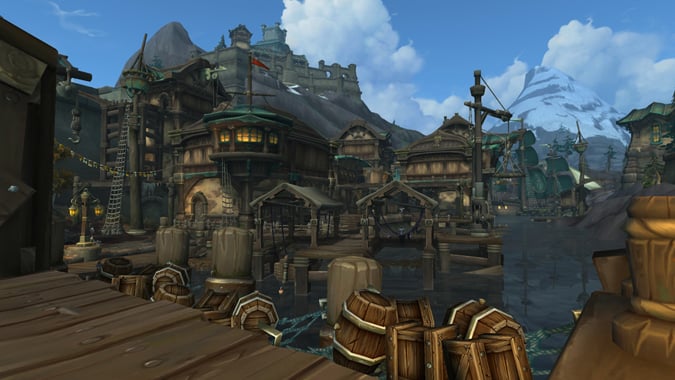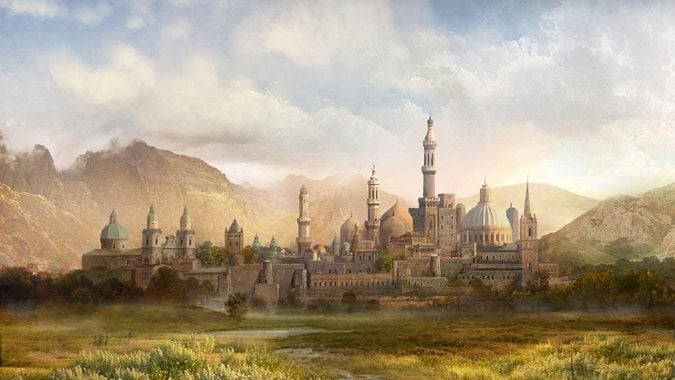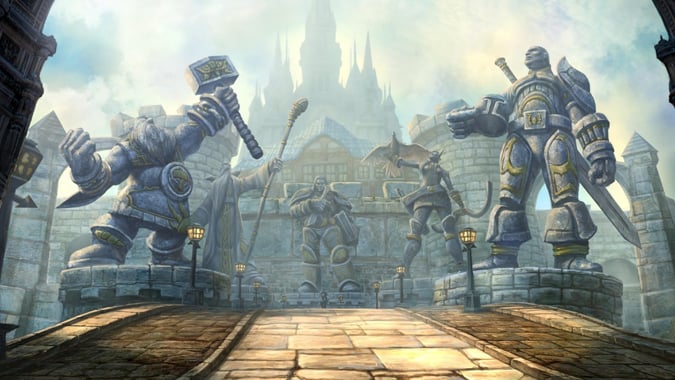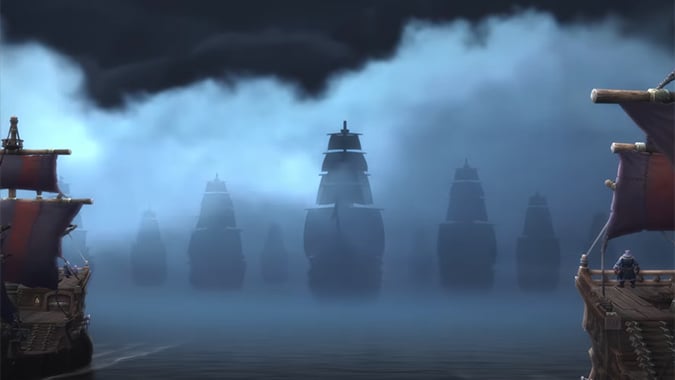Know Your Lore: Kul Tiras’ place in the seven Human kingdoms and its future in the Alliance

Long ago, the empire of Arathor splintered into seven distinct kingdoms: Lordaeron, Dalaran, Gilneas, Stromgarde, Alterac, Stormwind, and Kul Tiras. One by one, each of those kingdoms either crumbled or withdrew. By the time we as players entered Azeroth’s timeline in World of Warcraft, only one of these kingdoms remained: Stormwind. It was where Human character began a journey that took them around the world.
In those days we had a violet bubble where Dalaran once stood, a great wall where Gilneas was purported to be, ruins populated by the Forsaken where Lordaeron had been, and Kul Tiras…well, nobody knew where Kul Tiras was. But as the years have passed, Stormwind has slowly been rejoined by the seven, in one form or another. First Dalaran entered the fray as a neutral city in Wrath. Then Gilneas – or at least its citizens – joined in during Cataclysm.
Now, Kul Tiras has re-entered the picture. But what does that mean for the future of the naval kingdom?
Note that this Know Your Lore contains spoilers for the end of the Alliance story campaign. If you have yet to finish the Siege of Boralus, you may want to return once you’ve done so.

Alliance of Lordaeron
If one takes a step back and looks at the Burning Legion’s game as a lengthy one, the fallout from the Second War wasn’t exactly a defeat. After the fall of the first Horde, the seven kingdoms – once thoroughly united – began to splinter. Alterac had already been by and large ended with the overthrow of Perenolde during the Second War. Both Gilneas and Stromgarde left after tensions arose regarding the fate of the Orcs captured after the war had ended.
In the Third War, the Burning Legion only managed to fracture things further. The arrival of the Plague in Lordaeron brought the nation to its knees. Dalaran was nearly destroyed upon Archimonde’s arrival. As for Kul Tiras, it remained loyal to Lordaeron until the Scourge hit King Menethil’s kingdom. After that, Lord Admiral Daelin Proudmoore sailed to find his daughter Jaina…and we’re well aware of what happened to him at Theramore.
It’s the fallout from that incident that caused Kul Tiras to withdraw. As far as Kul Tiras was concerned, the Lord Admiral’s death was something that needed to be avenged. But by this time, the Alliance was in tatters – Gilneas was locked behind its wall, while Lordaeron was done for and overrun by Scourge. Stromgarde had fallen to sieges from both Syndicate and Boulderfist Ogres, and Dalaran remained behind a bubble, the health of its people largely unknown.
All that was left by that point was Stormwind, which was dealing with struggles of its own as a newly-rebuilt kingdom. In truth, there was little that could be done for Kul Tiras. Sure, the united forces of Human, Orc, and Night Elf might have defeated Archimonde and the Burning Legion at Hyjal…but the seven kingdoms were still fractured almost beyond repair.

Kingdoms return
Yet despite that, Stormwind continued on. Even in the midst of riots from unpaid laborers and the disappearance of its king – largely due to the meddling of a black dragon with a lot of time on her hands – Stormwind managed to survive. And eventually, those other kingdoms began to return. First it was Dalaran, making its reappearance during the war against the Lich King. Then Gilneas showed its face again – beleaguered by Worgen and Forsaken alike.
Now Kul Tiras has reentered the fray – and its reappearance means a lot more than either Dalaran or Gilneas, for a few key reasons. First, Dalaran was a neutral city-kingdom when it rejoined the fold. Although it wasn’t aligned with the Horde, it wasn’t aligned fully with the Alliance, either. That changed briefly with the fall of Theramore, but when Khadgar returned in Legion, it was to steer Dalaran back to that neutral stance.
Second, Gilneas had essentially been abandoned. As proud as Gilneas and its citizens were, they couldn’t withstand a direct assault by the Banshee Queen. Its people were now citizens of Teldrassil, refugees that no longer had a kingdom to call their own. Gilneas had nothing more to offer than its people and their loyalty – any resources were lost when the kingdom was abandoned.
Kul Tiras may have its problems, but it’s also a fully functioning kingdom with resources and a navy the likes of which we’ve never seen in World of Warcraft. Despite corruption from within and without, the citizens of Kul Tiras have shown a resilience that isn’t just something to be admired – it’s something that is a distinct advantage.

By the numbers
Throughout all of the history going on with the Alliance, the Horde have continued to pose a threat, sometimes more active than not. Throughout the years, the population between factions has been fairly even. If you break it down, at the onset of WoW, the Alliance consisted of one lone Human Kingdom, one Dwarven clan, a small subset of Gnomes that had been chased from their homes, and the Night Elves, who were easily the largest group out of them all.
Compare that to the Horde, which consisted of a small group of Orcs left over from the original Horde and one small Troll tribe in a population of thousands across the world. On top of that, they had the entire newly united population of Tauren tribes, and the Forsaken – who were essentially the formerly living citizens of the kingdom of Lordaeron.
Both factions added to their numbers in Burning Crusade – the Alliance brought in the beleaguered remnants of the Draenei population that fled Outland, and the Horde welcomed the small subset of Blood Elves left over after their numbers were decimated during the Third War. In Cataclysm, each faction took in another small group of refugees – Goblin and Worgen alike. The Pandaren split themselves between Alliance and Horde.
But when you add in Allied Races, the Horde has a pretty clear upper hand. They have the Highmountain, a well-established tribe of Tauren, and the Nightborne, remnants of the ancient kaldorei empire of old. In return, the Alliance picked up the Lightforged, a small but powerful army of Draenei, and the Void Elves, who are essentially an even smaller cast-off from the already low Blood Elf population.
And then we have Teldrassil. In one strike, Sylvanas Windrunner managed to crush what was arguably the strongest arm the Alliance had, by the numbers. Yes, the Alliance struck back at Lordaeron – but Sylvanas evacuated the city ahead of time. She bombed the city with the Plague herself, to keep it from falling into Alliance hands.

Alliances
And after that, the Horde went after the Trolls of Zandalar. The Zandalari Empire is somewhat diminished from the days of old, but it’s still powerful. Its numbers encompass not just the Zandalari, but several Troll tribes. Not everyone is going to fall in line with the Horde – but the Alliance doesn’t know that.
Kul Tiras is presented as a counterpoint to the Zandalar – an island nation with a navy that rivals even the Zandalari fleet. They have the numbers and the resources that the Alliance currently lacks. United as they are under the recently declared new Lord Admiral Jaina Proudmoore, Kul Tiras represents a fighting chance for the Alliance.
The other remnants of the original seven kingdoms may have fallen to ruin over the years, but Kul Tiras remains strong. Whether or not it’ll be enough to defeat the Horde remains to be seen…but between Jaina – who knows more about the Horde than most – at the helm, and the return of the Kul Tiran fleet, things are looking up for both the island nation, and the future of the Alliance as well.
Please consider supporting our Patreon!
Join the Discussion
Blizzard Watch is a safe space for all readers. By leaving comments on this site you agree to follow our commenting and community guidelines.
 @Shadesogrey
@Shadesogrey




